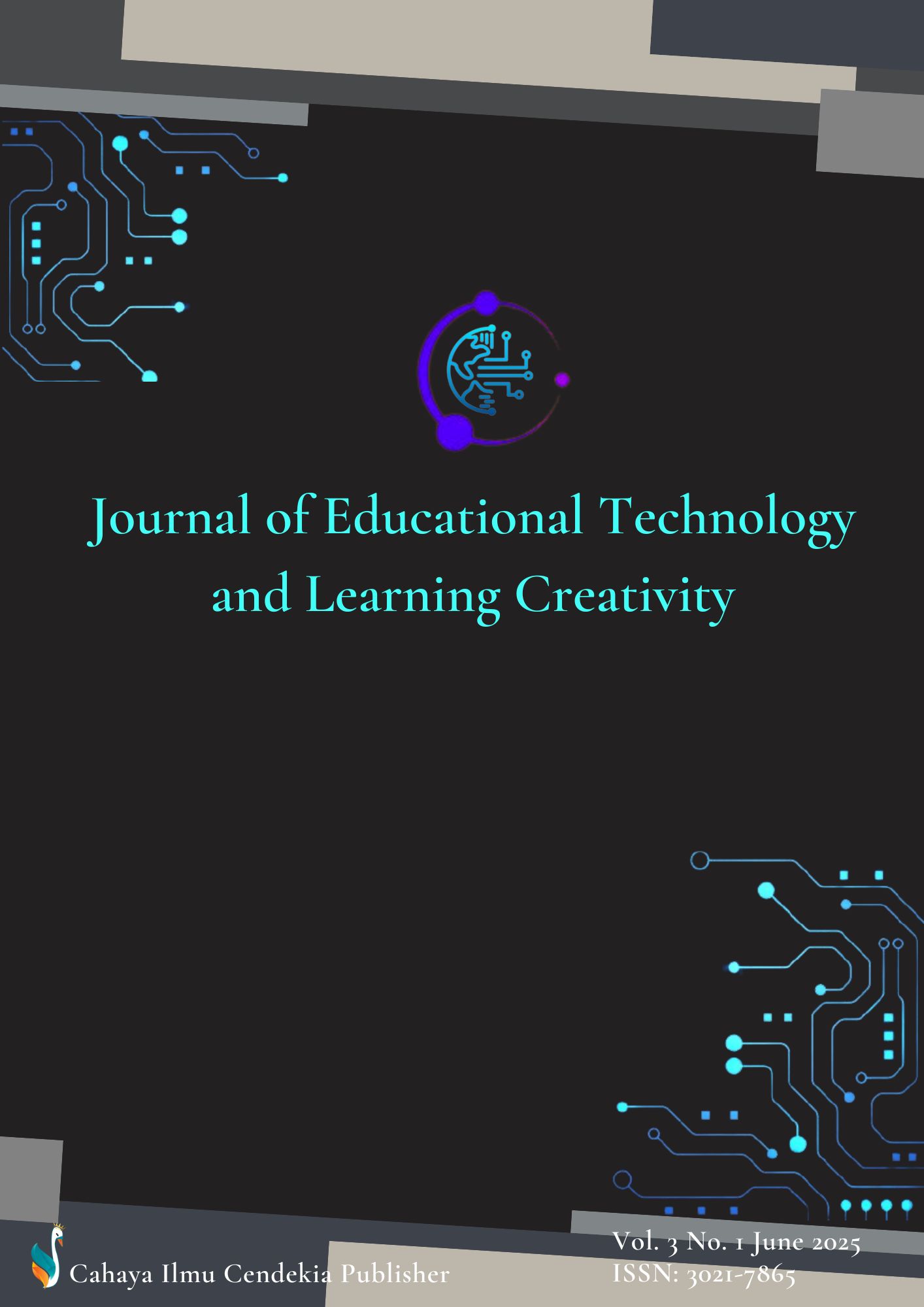The Effect of LED Light Intensity on the Growth of Spinach (Amaranthus sp.): A Comparative Study of Green and Red Varieties
Abstract
Purpose of the study: This study aims to examine the effect of LED light power on the growth of spinach plants (Amaranthus sp.) and compare the impact of different LED power levels on the growth of green and red spinach.
Methodology: This study used white LED lights (3W, 5W, 6.5W), a lux meter, thermometer, ruler, and camera. Green and red spinach seeds were planted in polybags with a soil and fertilizer mixture. An experimental method was applied with weekly growth measurements. Data were analyzed using descriptive statistical calculations.
Main Findings: The results show that 3W LED light provides the best growth for green and red spinach, with greater leaf width, leaf count, and stem height compared to 5W, 6.5W, and no light. Excess light (6.5W) hinders growth, while no light causes pale and wilted leaves. Red spinach grows faster than green spinach.
Novelty/Originality of this study: This study reveals that 3W LED light is more effective in promoting spinach growth than higher wattages or no additional light. These findings provide new insights into optimal light power selection for plant growth, benefiting urban farming, hydroponics, and indoor cultivation.
References
S. Zhen, M. W. van Iersel, and B. Bugbee, “Photosynthesis in sun and shade: the surprising importance of far-red photons,” New Phytol., vol. 236, no. 2, pp. 538–546, 2022, doi: 10.1111/nph.18375.
J. Walter and J. Kromdijk, “Here comes the sun: How optimization of photosynthetic light reactions can boost crop yields,” J. Integr. Plant Biol., vol. 64, no. 2, pp. 564–591, 2022, doi: 10.1111/jipb.13206.
E. Lo Piccolo et al., “LED streetlamps alter tree architecture, downregulate the photosynthetic process and alter the sugar metabolism of Populus alba L.,” Environ. Exp. Bot., vol. 226, no. June, p. 105861, 2024, doi: 10.1016/j.envexpbot.2024.105861.
S. I. Allakhverdiev, “Artificial photosynthesis: Powering a green new deal for sustainable energy,” Int. J. Hydrogen Energy, vol. 90, pp. 199–209, 2024, doi: 10.1016/j.ijhydene.2024.09.447.
G. Hu and F. You, “AI-enabled cyber-physical-biological systems for smart energy management and sustainable food production in a plant factory,” Appl. Energy, vol. 356, p. 122334, 2024, doi: 10.1016/j.apenergy.2023.122334.
M. Abdul Kareem Joyia et al., “Trends and advances in sustainable bioethanol production technologies from first to fourth generation: A critical review,” Energy Convers. Manag., vol. 321, p. 119037, 2024, doi: 10.1016/j.enconman.2024.119037.
Y. Sun et al., From remotely sensed solar-induced chlorophyll fluorescence to ecosystem structure, function, and service: Part I—Harnessing theory, vol. 29, no. 11. 2023. doi: 10.1111/gcb.16634.
W. de P. Bernado et al., “Biomass and leaf acclimations to ultraviolet solar radiation in juvenile plants of Coffea arabica and C. Canephora,” Plants, vol. 10, no. 4, 2021, doi: 10.3390/plants10040640.
E. A. Cutolo, Z. Guardini, L. Dall’Osto, and R. Bassi, “A paler shade of green: engineering cellular chlorophyll content to enhance photosynthesis in crowded environments,” New Phytol., vol. 239, no. 5, pp. 1567–1583, 2023, doi: 10.1111/nph.19064.
A. Garcia et al., “Enhancing crop yields through improvements in the efficiency of photosynthesis and respiration,” New Phytol., vol. 237, no. 1, pp. 60–77, 2023, doi: 10.1111/nph.18545.
P. da Fonseca-Pereira, J. A. Siqueira, R. de C. Monteiro-Batista, M. G. M. V. Vaz, A. Nunes-Nesi, and W. L. Araújo, “Using synthetic biology to improve photosynthesis for sustainable food production,” J. Biotechnol., vol. 359, pp. 1–14, 2022, doi: 10.1016/j.jbiotec.2022.09.010.
G. D. Barone et al., “Recent developments in the production and utilization of photosynthetic microorganisms for food applications,” Heliyon, vol. 9, no. 4, 2023, doi: 10.1016/j.heliyon.2023.e14708.
C. Yue, Z. Wang, and P. Yang, “Review: the effect of light on the key pigment compounds of photosensitive etiolated tea plant,” Bot. Stud., vol. 62, no. 1, 2021, doi: 10.1186/s40529-021-00329-2.
R. Paradiso and S. Proietti, “Light-quality manipulation to control plant growth and photomorphogenesis in greenhouse horticulture: the state of the art and the opportunities of modern LED systems,” J. Plant Growth Regul., vol. 41, no. 2, pp. 742–780, 2022, doi: 10.1007/s00344-021-10337-y.
P. Jian, Q. Zha, X. Hui, C. Tong, and D. Zhang, “Research progress of arbuscular mycorrhizal fungi improving plant resistance to temperature stress,” Horticulturae, vol. 10, no. 8, pp. 1–14, 2024, doi: 10.3390/horticulturae10080855.
D. Leister, “Enhancing the light reactions of photosynthesis: Strategies, controversies, and perspectives,” Mol. Plant, vol. 16, no. 1, pp. 4–22, 2023, doi: 10.1016/j.molp.2022.08.005.
W. Wasilewska-Dębowska, M. Zienkiewicz, and A. Drozak, “How light reactions of photosynthesis in C4 plants are optimized and protected under high light conditions,” Int. J. Mol. Sci., vol. 23, no. 7, 2022, doi: 10.3390/ijms23073626.
S. Hussain et al., “Photosynthesis research under climate change,” Photosynth. Res., vol. 150, no. 1–3, pp. 5–19, 2021, doi: 10.1007/s11120-021-00861-z.
J. Sosnowski, M. Truba, and V. Vasileva, “The impact of auxin and cytokinin on the growth and development of selected crops,” Agric., vol. 13, no. 3, pp. 1–14, 2023, doi: 10.3390/agriculture13030724.
A. Korobova et al., “Effect of low light stress on distribution of auxin (indole-3-acetic acid) between shoot and roots and development of lateral roots in barley plants,” Biology (Basel)., vol. 12, no. 6, 2023, doi: 10.3390/biology12060787.
V. Cavallaro, A. Pellegrino, R. Muleo, and I. Forgione, “Light and plant growth regulators on in vitro proliferation,” Plants, vol. 11, no. 7, pp. 1–45, 2022, doi: 10.3390/plants11070844.
S. Peng and X. Qin, “Application of phytonanotechnology for modern sustainable green agriculture: Promising opportunities and scientific challenges,” Ind. Crops Prod., vol. 218, p. 119001, 2024, doi: 10.1016/j.indcrop.2024.119001.
R. Alonso-Salinas, S. López-Miranda, A. J. Pérez-López, and J. R. Acosta-Motos, “Strategies to delay ethylene-mediated ripening in climacteric fruits: implications for shelf life extension and postharvest quality,” Horticulturae, vol. 10, no. 8, 2024, doi: 10.3390/horticulturae10080840.
U. Rogo, M. Fambrini, and C. Pugliesi, “Embryo rescue in plant breeding,” Plants, vol. 12, no. 17, 2023, doi: 10.3390/plants12173106.
H. Pamukçu, Ö. Saraç, S. Aytuğar, and M. Sandıkçı, “The effects of local food and local products with geographical indication on the development of tourism gastronomy,” Sustain., vol. 13, no. 12, pp. 1–13, 2021, doi: 10.3390/su13126692.
J. P. Trigo, A. Elisabete M. C., S. Jorge A., and M. E. and Pintado, “High value-added compounds from fruit and vegetable by-products – Characterization, bioactivities, and application in the development of novel food products,” Crit. Rev. Food Sci. Nutr., vol. 60, no. 8, pp. 1388–1416, Mar. 2022, doi: 10.1080/10408398.2019.1572588.
H. Górska-Warsewicz, K. Rejman, J. Kaczorowska, and W. Laskowski, “Vegetables, potatoes and their products as sources of energy and nutrients to the average diet in poland,” Int. J. Environ. Res. Public Health, vol. 18, no. 6, pp. 1–23, 2021, doi: 10.3390/ijerph18063217.
B. Nemzer, F. Al-Taher, and N. Abshiru, “Extraction and natural bioactive molecules characterization in spinach, kale and purslane: A comparative study,” Molecules, vol. 26, no. 9, pp. 1–13, 2021, doi: 10.3390/molecules26092515.
C. Roumeliotis, A. S. Siomos, and D. Gerasopoulos, “Comparative nutritional and antioxidant compounds of organic and conventional vegetables during the main market availability period,” Nitrogen (Switzerland), vol. 2, no. 1, pp. 18–29, 2021, doi: 10.3390/nitrogen2010002.
O. S. Abdoellah et al., “Between food fulfillment and income: Can urban agriculture contribute to both?,” Geogr. Sustain., vol. 4, no. 2, pp. 127–137, 2023, doi: 10.1016/j.geosus.2023.03.001.
K. Obaideen, N. Shehata, E. T. Sayed, M. A. Abdelkareem, M. S. Mahmoud, and A. G. Olabi, “The role of wastewater treatment in achieving sustainable development goals (SDGs) and sustainability guideline,” Energy Nexus, vol. 7, no. July, p. 100112, 2022, doi: 10.1016/j.nexus.2022.100112.
C. Narvaez Rojas, G. A. Alomia Peñafiel, D. F. Loaiza Buitrago, and C. A. Tavera Romero, “Society 5.0: A Japanese concept for a superintelligent society,” Sustain., vol. 13, no. 12, 2021, doi: 10.3390/su13126567.
Q. Fang et al., “The invisible tropical tuber crop: edible aroids (Araceae) sold as ‘Tajer’ in the Netherlands,” Econ. Bot., vol. 79, no. 0123456789, pp. 44–64, 2024, doi: 10.1007/s12231-024-09624-y.
A. Ribera, R. van Treuren, C. Kik, Y. Bai, and A. M. A. Wolters, “On the origin and dispersal of cultivated spinach (Spinacia oleracea L.),” Genet. Resour. Crop Evol., vol. 68, no. 3, pp. 1023–1032, 2021, doi: 10.1007/s10722-020-01042-y.
T. Beal et al., “Friend or foe? the role of animal-source foods in halthy and environmentally sustainable diets,” J. Nutr., vol. 153, no. 2, pp. 409–425, 2023, doi: 10.1016/j.tjnut.2022.10.016.
M. W. J. Noort et al., “Towards sustainable shifts to healthy diets and food security in sub-Saharan Africa with climate-resilient crops in bread-type products: a food system analysis,” Foods, vol. 11, no. 2, 2022, doi: 10.3390/foods11020135.
E. J. M. Feskens et al., “Women’s health: optimal nutrition throughout the lifecycle,” Eur. J. Nutr., vol. 61, no. s1, pp. 1–23, 2022, doi: 10.1007/s00394-022-02915-x.
P. A. Y. Ampim, E. Obeng, and E. Olvera-Gonzalez, “Indoor vegetable production: an alternative approach to increasing cultivation,” Plants, vol. 11, no. 21, pp. 1–28, 2022, doi: 10.3390/plants11212843.
Y. Yusriadi, A. Cahaya, and F. Hamzah, “Farmer adaptation strategies through local farming systems in Enrekang, Indonesia,” Sci. Rep., vol. 14, no. 1, pp. 1–14, 2024, doi: 10.1038/s41598-024-72953-4.
O. Thepsilvisut et al., “Efficacy of agricultural and food wastes as the growing media for sunflower and water spinach microgreens production,” Horticulturae, vol. 9, no. 8, pp. 1–17, 2023, doi: 10.3390/horticulturae9080876.
S. Sereenonchai and N. Arunrat, “Communication strategies for sustainable urban agriculture in Thailand,” Sustain., vol. 16, no. 24, 2024, doi: 10.3390/su162410898.
A. Sae-Eaw, S. Wongsaichia, D. Giacalone, P. Naruetharadhol, and C. Ketkaew, “Conceptualizing a gluten-Free Instant Noodle Prototype Using Environmental Sustainability Aspects: A Cross-National Qualitative Study on Thai and Danish Consumers,” Foods, vol. 11, no. 16, 2022, doi: 10.3390/foods11162437.
S. Kaur, “Barriers to consumption of fruits and vegetables and strategies to overcome them in low- and middle-income countries: a narrative review,” Nutr. Res. Rev., vol. 36, no. 2, pp. 420–447, 2023, doi: 10.1017/S0954422422000166.
A. Martínez-Moreno, A. Frutos-Tortosa, H. Diaz-Mula, T. C. Mestre, and V. Martínez, “Effect of the intensity and spectral quality of LED light on yield and nitrate accumulation in vegetables,” HortScience, vol. 54, no. 10, pp. 1745–1750, 2024, doi: 10.21273/HORTSCI14263-19.
W. Gao, D. He, F. Ji, S. Zhang, and J. Zheng, “Effects of daily light integral and LED spectrum on growth and nutritional quality of hydroponic spinach,” Agronomy, vol. 10, no. 8, 2020, doi: 10.3390/agronomy10081082.
T. P. D. Nguyen, T. T. H. Tran, and Q. T. Nguyen, “Effects of light intensity on the growth, photosynthesis and leaf microstructure of hydroponic cultivated spinach (Spinacia oleracea L.) under a combination of red and blue LEDs in house,” Int. J. Agric. Technol., vol. 15, no. 1, pp. 75–90, 2019.
U. Lőrinc, M. István, V. Balázs, P. Zoltán, and D. Éva, “Effects of light intensity and spectral composition on the growth and metabolism of spinach (SPINACIA OLERACEA L.),” Acta Biol. Plant. Agriensis, no. 7, pp. 3–18, 2019, doi: 10.21406/abpa.2019.7.3.
Copyright (c) 2025 Supamas Intharit, Leah Navarro, Apichai Chanudom

This work is licensed under a Creative Commons Attribution 4.0 International License.
Authors who publish with this journal agree to the following terms:
- Authors retain copyright and acknowledge that the Journal of Educational Technology and Learning Creativity is the first publisher licensed under a Creative Commons Attribution 4.0 International License.
- Authors are able to enter into separate, additional contractual arrangements for the non-exclusive distribution of the journal's published version of the work (e.g., post it to an institutional repository or publish it in a book), with an acknowledgment of its initial publication in this journal.
- Authors are permitted and encouraged to post their work online (e.g., in institutional repositories or on their website) prior to and during the submission process, as it can lead to productive exchanges and earlier and greater citation of published work.


.png)


.png)
.png)
.png)












